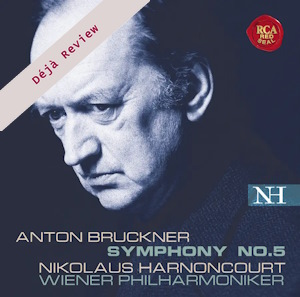
Déjà Review: this review was first published in March 2005 and the recording is still available.
Anton Bruckner (1824-1896)
Symphony No. 5 in B flat major (1876)
Vienna Philharmonic Orchestra/Nikolaus Harnoncourt
rec. 2004, Musikverein, Vienna
Originally reviewed as SACD 82876 607492 with second disc of rehearsal extracts
RCA G010003192493A [73]
Nikolaus Harnoncourt has developed a close relationship with the Vienna Philharmonic Orchestra. He conducted the most recent New Year’s Day concert of Viennese Music at the Musikverein, and he has made various keynote recordings, including discs which mark him as a major Bruckner conductor.
There is no question that Harnoncourt knows and loves this music. He leads an interpretation which has long-term vision as well as short term attention to detail. There is room for inwardness as there is also for powerful intensity. Both these characteristics are to be found in the remarkable slow movement, whose tempo here is flowing and spontaneous. The result is that the performing time of just under 15 minutes contrasts strongly, for example, with Karajan’s of more than 21 minutes. It is a tribute to Bruckner’s mastery that in performance either of these approaches will give the impression that the music could not possibly be otherwise. Perhaps Harnoncourt does miss something of Bruckner’s depth of spirituality in this movement, but the flowing line achieves compensations of its own. It all goes to show that a great symphony is always greater than any one performance of it.
The recording is based on a live performance and has all the extra frisson that such an occasion generates. No doubt a few extra touches were added from the rehearsal sessions that were also recorded. Extracts from the latter are included on a second CD, the proceedings conducted in German of course. The booklet notes do include careful referencing, but there is no German translation for those who might need one.
It goes without saying that the playing of the Vienna Philharmonic is superlative, but the most striking aspects in this regard are the quieter moments, particularly from the strings. The recorded sound is always a crucial factor in Bruckner, as is the acoustic in a live performance. For the latter, the Musikverein is splendid, while the sound itself is capable of accommodating the naturally wide range of dynamics with consummate ease. However, the microphone placings must have been different for the rehearsals, at which the sound seems altogether more boxy. Presumably this had something to do with Harnoncourt’s vocal contributions being appropriately captured.
The outer movements are handled with a rare understanding of structure, so that the ebb and flow of tempi, of the musical line’s moments of tension and relaxation, are achieved without any sense of imposed force. Nowhere is this more important than in the closing stages of the work, with the inevitable return of the first movement’s principal theme. This reinforces the strength of the peroration and sets the bond of unity upon the remarkable vision of this great symphonic master.
Terry Barfoot
Help us financially by purchasing from



















